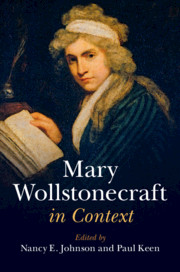Book contents
- Mary Wollstonecraft in Context
- Mary Wollstonecraft in Context
- Copyright page
- Contents
- Illustrations
- Notes on Contributors
- Preface
- Frontispiece
- Chronology
- Part I Life and Works
- Chapter 1 Biography
- Chapter 2 Correspondence
- Chapter 3 Family
- Chapter 4 Joseph Johnson
- Part II Critical Fortunes
- Part III Historical and Cultural Contexts
- Suggested Further Reading
- Index
Chapter 1 - Biography
from Part I - Life and Works
Published online by Cambridge University Press: 16 January 2020
- Mary Wollstonecraft in Context
- Mary Wollstonecraft in Context
- Copyright page
- Contents
- Illustrations
- Notes on Contributors
- Preface
- Frontispiece
- Chronology
- Part I Life and Works
- Chapter 1 Biography
- Chapter 2 Correspondence
- Chapter 3 Family
- Chapter 4 Joseph Johnson
- Part II Critical Fortunes
- Part III Historical and Cultural Contexts
- Suggested Further Reading
- Index
Summary
On the night of December 26, 1792, Mary Wollstonecraft, alone in her apartment on the rue Meslée in Paris, sat writing a letter to her publisher Joseph Johnson in London. “Once or twice, lifting my eyes from the paper, I have seen eyes glare through a glass-door opposite my chair, and bloody hands shook at me … I want to see something alive; death in so many frightful shapes has taken hold of my fancy.—I am going to bed—and, for the first time in my life, I cannot put out the candle.”1 She had crossed the Channel to witness the events in France, inspired by the revolutionaries’ attempt to create a more equal society along republican lines. But the silent streets as Louis XVI passed by on his way to trial, so dignified in the face of what she knew to be certain death, shocked her. Wollstonecraft was fierce in argument, quick to pass judgment, sensitive to injustice, but always keenly aware of the springs of human action.
- Type
- Chapter
- Information
- Mary Wollstonecraft in Context , pp. 3 - 10Publisher: Cambridge University PressPrint publication year: 2020

